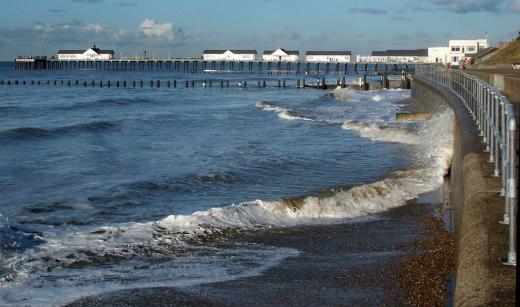What is a Neap Tide?
 Mary McMahon
Mary McMahon
A neap tide is a relatively low high tide, or a generally low tidal range between low and high tides. During the moon's first and third quarter, periods of neap tides are experienced, due to the way in which the sun and moon act on the Earth to create tides. The opposite of a neap tide is a spring tide, a strong tide which is extremely high or very low, creating a large tidal range. Because the tidal cycle is well known, scientists can predict when spring and neap tides will occur, and how high they will be.
Tides are caused by an interaction of factors. The spinning motion of the Earth plays a role, as do the gravitational pulls of the moon and the Sun. In a neap tide, the sun and moon are at right angles to each other, pulling in opposite directions. These pulls effectively balance each other out, keeping the water level relatively stable. While low and high tides do occur during a neap tide, the range in height between them is very minimal.

By contrast, in a spring tide, the Sun, moon, and Earth are in syzygy, which means that they are all lined up in a row. Since the Sun and moon are pulling together, they generate a much greater force, creating correspondingly higher and lower tides. During spring tides, people can take advantage of the low tide to gather various organisms from rocks which are normally covered by water, and ships may also time departures and arrivals to coincide with the tide.

The sun and moon orient themselves to create a neap tide when the moon is one quarter full, which occurs twice during the lunar cycle. Spring tides occur when the moon is full and dark. People who want to get a rough idea of what to expect from the tides can check and see where in the lunar cycle they are to determine if there will be a neap or spring tide. Additional information about when high and low tides will occur can be gathered from organizations which provide weather and tide data.

People may want to be aware that the topography of the Earth influences tides, which is one reason why tidal levels are not the same all over the Earth, or even in a similar region of the Earth. Tide charts generally indicate the area they apply to, and some have conversion tables which can be used in neighboring regions to determine when the high and low tides will occur, and what their heights will be.
AS FEATURED ON:
AS FEATURED ON:














Discussion Comments
One matter omitted from this article is the reference to what could be a "flat" neap tide, where the high and low water is basically the same, with no tidal movement for say 24 hours. This only occurs in a few places worldwide, including the Gulf of Mexico and the Gulf of St Vincent, in South Australia, where it is referred to as a "Dodge" tide.
@ GlassAxe- Ship navigators often use tide charts in combination with tide clocks. Cartographers chart tides relative to a certain region, and take into account the tidal effects of the local topography. These tools are more accurate at determining tidal activity, whereas a tidal clock is used as a reference to get a relative idea of when the high or low tide will occur.
@ PelesTears- I have seen dive and surf watches with tidal clocks built-in, and I have always wondered how they work. I never knew that tides came on regular intervals or that there were such things as spring tides and neap tides. Between what you wrote, and what the author of the article wrote, I have learned a lot about how the tides work.
I do have a question though. How do sailors and other ocean navigators use tide clocks to navigate the seas?
Tide clocks are popular clocks used amongst surfers, sailors, and anyone else who is concerned with the tidal cycle. They run on a 12 hour and 25 minute cycle, which is the time it takes for the high tide to ebb and flow back to high tide again.
The accuracy of a tide clock is dependent on when it is set. This is because of the lunitidal interval, which has to do with the location of the sun relative to the moon. During the spring tide, the solar and lunar tidal effects are synchronized since the sun and moon are in alignment. During a neap tide, the synchronization is off since the moon and sun are at right angles of each other.
This is why the neap tide is the weakest tide, and the spring tide the strongest. A tidal clock that is set during the spring tide will be more accurate than one set during the neap tide.
Post your comments